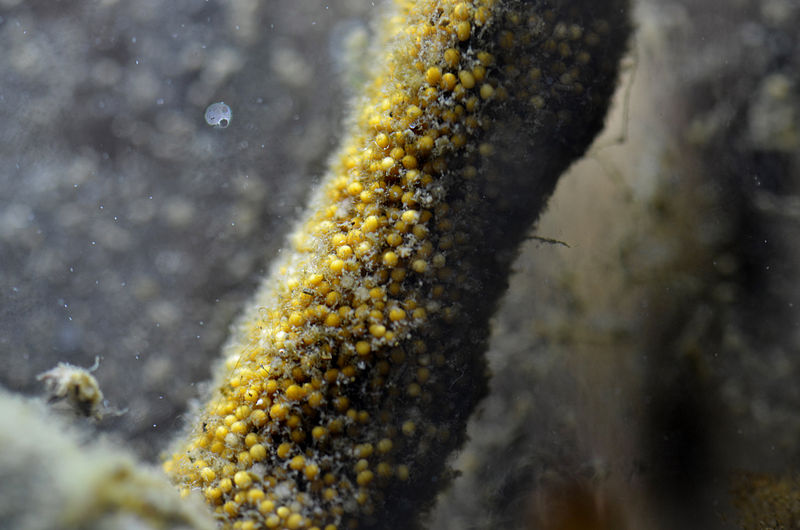What is the Difference Between Budding and Gemmule Formation
The key difference between budding and gemmule formation is that budding is an asexual reproduction method in which a bud grows externally on the surface of the parent, while gemmule formation is an asexual reproduction method in which buds or gemmules form internally inside the parent body.
Budding is a type of asexual reproduction. Buds can develop inside or outside the parent body. Bud formation occurs as a result of mitotic cell division. Hence, it produces offspring genetically identical to the mother. When buds form inside the organisms’ body, we call it internal budding or endogenous budding or gemmule formation. Internal buds are known as gemmules and this gemmule formation is commonly seen in sponges like Spongilia.
CONTENTS
1. Overview and Key Difference
2. What is Budding
3. What is Gemmule Formation
4. Similarities – Budding and Gemmule Formation
5. Budding vs Gemmule Formation in Tabular Form
6. Summary – Budding vs Gemmule Formation
What is Budding?
Budding is a type of asexual reproduction shown by certain living organisms. In this process, a new organism develops as a form of an outgrowth or a bud on the surface of the mother cell. It develops externally on the mother parent. Hence, it is also known as exogenous budding. In fact, this is the usual form of budding. The new organism matures while attached to the mother cell. Once it becomes fully matured, it detaches from the parent and lives as an independent organism.

Figure 01: Budding
Budding is commonly seen in hydra, obelia, scypha and yeast. Hydra uses regenerative cells for budding. Due to the repeated mitotic cell division at one specific site, buds develop outside of the hydra body as tiny individuals. When they are mature enough, they separate from the parent hydra and become independent hydra. Budding is the most common mode of reproduction in yeasts. Yeasts are unicellular. A small cell forms on the parent yeast cell. The parent nucleus splits and makes a daughter nucleus in order to send to the daughter cell.
What is Gemmule Formation?
Gemmule formation is another way of asexual reproduction. Gemmule formation is also known as internal budding or endogenous budding. In gemmule formation, new organisms or buds develop within the mother organism. Hence, gemmules or buds develop inside the parent. This type of internal budding is seen in sponges belonging to the phylum Porifera. Spongilla is a genus of sponges that shows gemmule formation. Inside the mother spongllia, several gemmules form, and they mature inside. Then they come out from the central cavity via an opening and become independent individuals. Each and every gemmule is capable of becoming a new individual.

Figure 02: Gemmule Formation
Gemmules have a resistant cover. Therefore, gemmules allow sponges to survive under adverse environmental conditions. Gemmules can tolerate desiccation or freezing. Thus, gemmules can be considered dormant sponge bodies. When the conditions are favourable, gemmules resume growing into fully matured sponges. Bacterial endospores are analogous to gemmules of sponges.
What are the Similarities Between Budding and Gemmule Formation?
- Budding and gemmule formation are two types of asexual reproduction methods.
- Parents and offspring are genetically identical in both methods.
- Buds or gemmule formation occur due to mitosis.
What is the Difference Between Budding and Gemmule Formation?
Budding is a mode of asexual reproduction which forms a new bud outside the parent, while gemmule formation is a type of asexual reproduction in which gemmules or buds grow inside the parent body. Therefore, buds develop externally while gemmules develop internally. So, this is the key difference between budding and gemmule formation. Moreover, unlike buds, gemmules have a resistant cover to act as dormant structures during adverse environmental conditions.
The below infographic lists the differences between budding and gemmule formation in tabular form for side by side comparison.
Summary – Budding vs Gemmule Formation
New buds form externally on the body surface of the parent in budding, which is an asexual method of reproduction in yeasts, hydra and scypha. Gemmule formation, also known as internal budding, involves the formation of a mass of cells or gemmules inside the parent organism. Gemmule formation is a characteristic feature of sponges. The key difference between budding and gemmule formation is that buds develop externally while gemmules develop internally.
Reference:
1. Bart, Martijn C, et al. “Spiculous Skeleton Formation in the Freshwater Sponge Ephydatia Fluviatilis under Hypergravity Conditions.” PeerJ, PeerJ Inc., 4 Jan. 2019.
2. “Gemmule.” Wikipedia, Wikimedia Foundation, 23 Apr. 2021.
Image Courtesy:
1. “Figure 43 01 02” By CNX OpenStax – (CC BY 4.0) via Commons Wikimedia
2. “Gemmules Spongilla lacustris 2014-11-16 a 3742” By Lamiot – Own work (CC BY-SA 4.0) via Commons Wikimedia
ncG1vNJzZmivp6x7pbXFn5yrnZ6YsqOx07CcnqZemLyue9ahmK1lmah6tbTEZpuinpaav6a6wp5km52krLKmuoybrJ2cmaO0bq3NnWSgnZ2iwq2xjJ%2Bmq6WRqbawuo4%3D